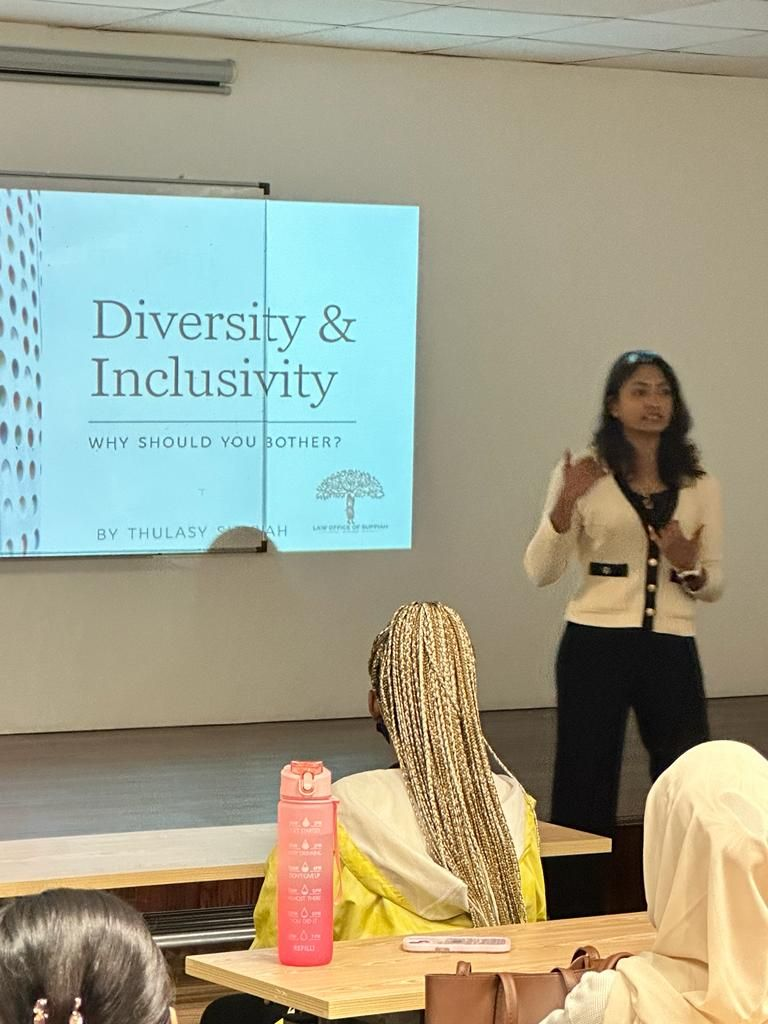
Diversity and inclusivity are not just buzzwords; they are essential for fostering innovation, driving creativity, and ensuring a fair and equitable society. We at MAHSA would like to thank Ms Thulasy Suppiah from the Law Office of Suppiah, Current Co-Chair of the Professional Development Committee, KL Bar Committee and Former Chair of the Gender Equality & Diversity Committee, KL Bar Committee (2021-2022) for enlightening us with her knowledge and expertise on this topic.
In summary, here's why bothering with Diversity & Inclusivity is crucial:
Innovation: Diverse teams bring together individuals with different backgrounds, experiences, and perspectives. This diversity of thought sparks creativity and innovation, leading to better problem-solving and more robust decision-making processes.
Better Decision Making: Inclusive environments encourage open communication and collaboration among team members. When everyone feels valued and empowered to contribute, decisions are more well-rounded and reflective of various viewpoints.
Broader Talent Pool: Embracing diversity attracts a wider range of talent. By creating an inclusive workplace culture, organizations can tap into a more diverse pool of candidates, enhancing their ability to attract and retain top talent.
Market Relevance: In today's increasingly globalized world, diverse and inclusive companies are better positioned to understand and meet the needs of diverse customer bases. This understanding translates into more relevant products and services, ultimately driving business growth and success.
Legal and Ethical Imperatives: Beyond the business case, there are legal and ethical imperatives for diversity and inclusivity. Discrimination and exclusion based on factors like race, gender, sexuality, or disability are not only morally wrong but also illegal in many jurisdictions.
Social Responsibility: Embracing diversity and inclusivity is a fundamental aspect of being socially responsible. It's about creating environments where everyone has equal opportunities to thrive, regardless of their background or identity.
Employee Satisfaction and Retention: Inclusive workplaces foster a sense of belonging and psychological safety among employees. When people feel valued and respected for who they are, they are more likely to be engaged, productive, and committed to their organization.
Risk Mitigation: Ignoring diversity and inclusivity can lead to reputational damage and legal risks. Instances of discrimination or exclusion can result in costly lawsuits, damage to brand reputation, and loss of customer trust.
Diversity and inclusivity are not just moral imperatives; they are also smart business strategies. By embracing diversity and fostering inclusivity, organizations can drive innovation, enhance decision-making, attract top talent, and build stronger connections with customers and communities.
Innovation: Diverse teams bring together individuals with different backgrounds, experiences, and perspectives. This diversity of thought sparks creativity and innovation, leading to better problem-solving and more robust decision-making processes.
Better Decision Making: Inclusive environments encourage open communication and collaboration among team members. When everyone feels valued and empowered to contribute, decisions are more well-rounded and reflective of various viewpoints.
Broader Talent Pool: Embracing diversity attracts a wider range of talent. By creating an inclusive workplace culture, organizations can tap into a more diverse pool of candidates, enhancing their ability to attract and retain top talent.
Market Relevance: In today's increasingly globalized world, diverse and inclusive companies are better positioned to understand and meet the needs of diverse customer bases. This understanding translates into more relevant products and services, ultimately driving business growth and success.
Legal and Ethical Imperatives: Beyond the business case, there are legal and ethical imperatives for diversity and inclusivity. Discrimination and exclusion based on factors like race, gender, sexuality, or disability are not only morally wrong but also illegal in many jurisdictions.
Social Responsibility: Embracing diversity and inclusivity is a fundamental aspect of being socially responsible. It's about creating environments where everyone has equal opportunities to thrive, regardless of their background or identity.
Employee Satisfaction and Retention: Inclusive workplaces foster a sense of belonging and psychological safety among employees. When people feel valued and respected for who they are, they are more likely to be engaged, productive, and committed to their organization.
Risk Mitigation: Ignoring diversity and inclusivity can lead to reputational damage and legal risks. Instances of discrimination or exclusion can result in costly lawsuits, damage to brand reputation, and loss of customer trust.
Diversity and inclusivity are not just moral imperatives; they are also smart business strategies. By embracing diversity and fostering inclusivity, organizations can drive innovation, enhance decision-making, attract top talent, and build stronger connections with customers and communities.
Look out for more interesting talks such as this in our Student Experience Weekends each month of 2024. For more info: STUDENT EXPERIENCE WEEKEND



